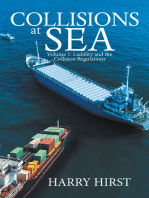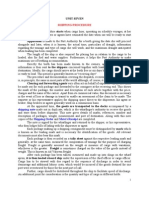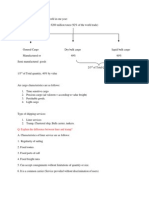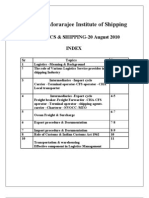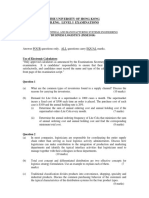English Iv Unit 1
English Iv Unit 1
Uploaded by
Rizky Akbar MillensepdhioCopyright:
Available Formats
English Iv Unit 1
English Iv Unit 1
Uploaded by
Rizky Akbar MillensepdhioOriginal Description:
Original Title
Copyright
Available Formats
Share this document
Did you find this document useful?
Is this content inappropriate?
Copyright:
Available Formats
English Iv Unit 1
English Iv Unit 1
Uploaded by
Rizky Akbar MillensepdhioCopyright:
Available Formats
ENGLISH IV
By :
R. Akbar M. (07.19.019.1.04)
D-IV Transportasi Laut Polbit
MERCHANT MARINE POLYTECHNIC OF SURABAYA
ACADEMIC YEAR 2021/2022
UNIT 1
SHIPPING PROCEDURE
(Individual Task from Reading Activity)
1. What must be known before the shipping of goods by sea starts ?
=> When cargo liner operating on schedule voyages at the terminal port, and
the owners or agents have estimated the date when it will be ready to start loading
for the next voyage.
=> Additional answer in my opinion :
a. Item Type ;
b. Item Weight ;
c. Item Purpose ;
d. Shipper and Consignee ;
e. Ship Length and Width ;
f. Order Receipt ; and
g. Shipping Documents.
2. What information is given in the application to the port authority ?
=> For a berth giving the date it will proceed alongside and later, when it is
known, the actual time, particulars of draught, information regarding the tonnage
and type of cargo it will work, and the maximum draught anticipated when
loading has been completed.
3. What are the “receiving days” ?
=> The cargo should arrive at the berth five or six days before the ship docks
or is ready to load.
=> Additional answer in my opinion :
Receipt of goods from Service Users, to the temporary Container Yard. To
be immediately loaded and handed over to the Consignee.
4. Who often works on behalf of Exporters ?
=> Clearing and Forwarding Agents very often act on behalf of Exporters.
5. What are the functions of the invoice ?
=> Invoice shows the mark of the package, the number and description of each
article together with the price, charges, and the name of the carrier. Apart from its
commercial value, this document is necessary in the event of loss or damage in
transit to enable an assessment of the claim to be made.
=> Additional answer in my opinion :
Data storage of purchase details and payment terms. Become a valid
reference when there is a discrepancy in the payment process or delivery of the
goods. As a legitimate desire to resell an item someone else has purchased. It can
be said that the main function of this document is to include components in the
purchase details, the main function of an invoice is to bill consumers or
customers to make payments immediately.
6. What are the basic duties of the Shipper ?
=> The exporter or his representative applies for shipping space direct
to the shipowner, that agent or broker. which is Ship brokers or agents and do
generally work on a commission basis.
The note is signed by the wharfinger and returned to the shipper, or his
representative, who then lodges bills of lading with the ship owner or agent.
=> Additional answer in my opinion :
A company that offers warehouse rental and delivery services, which can
be a representative agent.
7. What is the function of the Shipping Note, and what are the other two
documents issued along with it ?
=> This note gives details of marks, references, number, and description of
packages, weight, measurement and port of destination. Along with this note
copies of the Shipping Order and Mate's Receipt are completed.
8. When is the Bill of Lading lodged ?
=> When the shipping note was signed by the wharfinger and returned to the
shipper, or the representative. who shipping agency then lodges bills of lading
with the ship owner or agent for realization of trade transactions.
=> Additional answer in my opinion :
In addition, the Bill of Lading is also evidence of the existence of a contract
of carriage between the sender and the shipping company on the basis of siding
with the ownership of the goods.
9. What is the “leading mark” ?
=> Each package making up a shipping consignment must be distinguished by
mark, it is necessary for identification of the goods. All relevant too documents
must also bear this mark.
10. What are the three bases for assessing freight ?
=> Freight is generally assessed on the weight, or measure of cargo, with
variations, whichever is the greater. Freight is sometimes charged on the value of
the goods instead of weight. After each package has been tallied, measured and
made up into slings on the wharf apron, it is then loaded aboard ship under the
supervision of the chief officer or cargo officer.
11. What are the basic conditions for stowing cargo on board ?
=> Cargo has to be stowed with due regard to the sequence of discharge in
order to avoid demurrage and additional labour costs, which would be incurred if
the goods destined for one port were overstowed by those for the next port of call.
Cargo should be distributed throughout the ship to facilitate speed of discharge,
an add points for consideration the quantity and cargo’s type in different holds.
12. When is the Ship’s Manifest prepared ?
=> When the ship has completed loading specification of all cargo on board is
prepared. Copies of manifests are provided by the custom or consular authorities
of the country of export and import. Separate manifests must be made out for
each port of destination.
=> Additional answer in my opinion :
At the time of making the manifest, the company agent has prepared B/L,
Vessel Number, Description of in advance Goods, Gross Weight, Carriage, and
Information, all of which can be known from the previous steps above. The data
in the Manifest must be the same as stated in the Vessel Bill of Lading. After the
Manifest is prepared, check the truth again. The manifest is closed on the sheet
from the last delivery with underneath. Name and stamp of the shipping company
branch accompanied by the signature of the branch head. Before the ship departs,
a set of Manifest must be submitted to the ship.
13. What is a cargo plan ?
=> Shows in diagrammatic form the longitudinal section of the ship and each
hold with its respective decks, with main consignments marked off by coloured
blocks related to each port of discharge.
=> Additional answer in my opinion :
To make a cargo plan, consideration is needed:
a. Ship stability ;
b. Condition and Location of Unloading Equipment ;
c. Deck Strength ;
d. The Volume of Loading and Carrying Capacity of the Ship.
14. Where and when is the clearance applied for ?
=> Where : The agent or master of the vessel, Applies for a clearance of the
ship at the local Customs House.
When : After loading operations are completed.
15. What conditions must be fulfilled before the Customs Clearance is issued to
the ship ?
=> Clearance isn’t given ‘till the Collector of Customs is satisfied documentary
evidence has been produced to testify that the cargo is in order, the necessary
permits have been procured, and Customs formalities complied with. The officer
issuing the clearance must also satisfy himself that harbour and light dues have
been paid, and that emigration and port health regulations have been carried out.
16. When is the cargo delivered to the consignee ?
=> On arrival at each port of call the respective cargo is discharged and
received and stored by the appointed authority who, in turn, delivers it to the
consignee on a bill when the freight has been paid. A bill of lading, being
negotiable, is sometimes transferred to the consignee through a bank who will
only release it after the freight and cost of the goods are settled.
GRAMMAR FOCUS
1. (The yes/no question is constructed based on the tenses and the auxiliary.)
a. Ship brokers generally work on a commission basis.
The Verb 1 = Work
Subject = Ship Brokers (They, Because Ship Brokers are Plural)
Do ship brokers generally work on a commission basis?
Yes, They Do.
No, They Don’t.
b. All the relevant documents bear the leading mark.
The Verb 1 = Bear
Subject = All the Relevant Documents (It, Cause Documents)
Does all the relevant documents bear the leading mark?
Yes, It Does.
No, It Doesn’t.
c. The master or agent applies for a clearance after the loading operations had
been completed.
The Verb 1 = Applies
Subject = The Master or Agent (He, Because Using or)
Does the master or agent applies for a clearance after the loading
operations had been completed?
Yes, He Does.
No, He Doesn’t.
d. The cargo plan shows in diagrammatic form the longitudinal section.
The Verb 1 = Shows
Subject = The Cargo Plan (It, Cause the Shapes are Sheets or Thoughts)
Does the cargo plan shows in diagrammatic form the longitudinal
section?
Yes, It Does.
No, It Doesn’t.
e. The ship has completed loading specification of all cargo on board.
The Verb 1 = Completed
Subject = The Ship (It, Because the Ship is Singular)
Does the ship has completed loading specification of all cargo on
board?
Yes, It Does.
No, It Doesn’t.
2. (Make questions of the QUESTION-WORD using What….?, Who ….?, Where ….?, How
….?, Why …? When …?, etc.)
a. When loading operations are completed the agent applies for a clearance of
the ship at the local Customs house. (When ...? What ...? Who ...? What ...
for? Where ...?)
When the agent applies for a clearance of the ship?
What was must be completed before the agent applies for a clearance?
Who’s that applies for a clearance of the ship?
What was must be completed before the agent applies for?
Where a place to clearance of the ship do?
b. Cargo should be distributed throughout the ship to facilitate speed of
discharge. (What ...? Where ...? Why ...?)
What was should be distributed throughout the ship to facilitate speed
of discharge?
Where was Cargo should be distributed?
Why was Cargo should be distributed throughout the ship?
c. Clearing and Forwarding agents very often act on behalf of exporters.
(Who ...? What kind of ...? How often ...? On whose behalf ...?)
Who are very often act on behalf of exporters?
What kind of Clearing and Forwarding agents who were represented on
goods shipment?
How often Clearing and Forwarding agents act on behalf of exporters?
On whose behalf Clearing and Forwarding agents very often act as
representative in shipping agency?
You might also like
- Asbatankvoy Charter PartyDocument6 pagesAsbatankvoy Charter Partyady stoNo ratings yet
- Collisions at Sea: Volume 1: Liability and the Collision RegulationsFrom EverandCollisions at Sea: Volume 1: Liability and the Collision RegulationsRating: 5 out of 5 stars5/5 (1)
- Case Study and Exam QuestionsDocument9 pagesCase Study and Exam QuestionsBruno Madaleno50% (2)
- Mba ProjectDocument61 pagesMba ProjectMidhat Khan0% (1)
- Manufacturing ERP Requirements TemplateDocument7 pagesManufacturing ERP Requirements TemplateAlaNo ratings yet
- Dead Freight ClaimsDocument34 pagesDead Freight ClaimsFritz Gerald Ceniza100% (4)
- T4-Cargo DocumentationDocument18 pagesT4-Cargo Documentationfadhilpunk100% (1)
- Clearing and Forwarding Terminology: Course ManualDocument79 pagesClearing and Forwarding Terminology: Course ManualMALIMA100% (2)
- xxxxPABLO FR PANAMA LETTER OF INTENT MILBERRY CONGODocument1 pagexxxxPABLO FR PANAMA LETTER OF INTENT MILBERRY CONGOHitendraSinh ParmarNo ratings yet
- Modul English 4Document47 pagesModul English 4nadNo ratings yet
- Unit07-Shippingprocedure 000Document9 pagesUnit07-Shippingprocedure 000Anita ŠkulićNo ratings yet
- English Iv Unit 2,3,4Document24 pagesEnglish Iv Unit 2,3,4Rizky Akbar MillensepdhioNo ratings yet
- Engleski IV 2.kolokvij KB (S.C) 2Document14 pagesEngleski IV 2.kolokvij KB (S.C) 2Petar GrginNo ratings yet
- Port Agent & Laytime CalculationDocument3 pagesPort Agent & Laytime CalculationMugilrajan DevarajanNo ratings yet
- Voyage FlowchartDocument1 pageVoyage Flowchartumesh100% (2)
- What Is Chartering? How To Charter A Vessel? Liner Trade Vs Tramp TradeDocument29 pagesWhat Is Chartering? How To Charter A Vessel? Liner Trade Vs Tramp TradeLâm Tố NhưNo ratings yet
- Notices of ReadinessDocument20 pagesNotices of ReadinessWhoAm1No ratings yet
- THE MASTER Duties During The VoyageDocument20 pagesTHE MASTER Duties During The VoyageLiga ITNo ratings yet
- UntitledDocument5 pagesUntitledHIMANSHU PALNo ratings yet
- Module 3 INTRODUCTION TO SEA CARRIAGE & CARRIAGE OF GOODSDocument51 pagesModule 3 INTRODUCTION TO SEA CARRIAGE & CARRIAGE OF GOODSRam SinghNo ratings yet
- THE MASTER DutiesDocument24 pagesTHE MASTER DutiesVlad Rosu100% (1)
- Liner ShippingDocument8 pagesLiner ShippingMayank BhattNo ratings yet
- Import ProcessDocument3 pagesImport ProcessMhsh GalfNo ratings yet
- Unit 12Document12 pagesUnit 12Smarty AbhishekNo ratings yet
- Chapter 4 GDTMQT - SVDocument81 pagesChapter 4 GDTMQT - SVNguyễn Thị TâmNo ratings yet
- Cargo Related DocumentsDocument56 pagesCargo Related Documentscell discharge100% (2)
- Chartering TermsDocument4 pagesChartering TermsCarlos Alberto Zamorano PizarroNo ratings yet
- EID Unit 2 PptsDocument48 pagesEID Unit 2 PptskhushwantNo ratings yet
- Engleza Vii - Cursuri Full Campus PDFDocument83 pagesEngleza Vii - Cursuri Full Campus PDFCosmin CaramanNo ratings yet
- Bản sao của Chapter 2- ShippingDocument85 pagesBản sao của Chapter 2- ShippingVũ Ngọc HàNo ratings yet
- Lecture 7 - DocumentationDocument31 pagesLecture 7 - Documentationshuting2teoh100% (2)
- Ship Op Compiled NotesDocument132 pagesShip Op Compiled NotesMithunNo ratings yet
- Logistics in International Business: Prof. V. P. Arora Associate ProfesorDocument37 pagesLogistics in International Business: Prof. V. P. Arora Associate ProfesorPriyank100% (1)
- Final Chartering and BrokingDocument5 pagesFinal Chartering and Brokingq5btjsngkgNo ratings yet
- Chapter 4 GDTMQT - SVDocument82 pagesChapter 4 GDTMQT - SVvin543214No ratings yet
- Cargo Handling and StowageDocument2 pagesCargo Handling and StowageFahredza Ar RosyidNo ratings yet
- A Day in The Life of A ShipbrokerDocument10 pagesA Day in The Life of A ShipbrokerJasonNo ratings yet
- Business AssignmentDocument8 pagesBusiness Assignmentc rkNo ratings yet
- International Logistic: (GFMA6053)Document8 pagesInternational Logistic: (GFMA6053)Farah GhazaliNo ratings yet
- Chartering & Chartering PracticeDocument8 pagesChartering & Chartering PracticegggggNo ratings yet
- Explained Ocean Shipment FlowDocument5 pagesExplained Ocean Shipment FlowNgân Nguyễn Vũ ThanhNo ratings yet
- A Day in The Life of A Shipbroker - Shipping and Freight ResourceDocument5 pagesA Day in The Life of A Shipbroker - Shipping and Freight ResourcetaufiqNo ratings yet
- Chapter Six PortDocument11 pagesChapter Six PortokongaonakNo ratings yet
- CHIEF OFFICER InterviewDocument10 pagesCHIEF OFFICER InterviewAhmad AlshiekhNo ratings yet
- Tieng Anh Hang HaiDocument60 pagesTieng Anh Hang HaiIsea MarineNo ratings yet
- Cau Hoi Bang Tieng Anh Cho Capt Va Dai PhoDocument7 pagesCau Hoi Bang Tieng Anh Cho Capt Va Dai PhoHoài ThanhNo ratings yet
- Charter Party Part 1Document21 pagesCharter Party Part 1Lương Trần Thủy TiênNo ratings yet
- 5 - Shipping Agencies Functions and ResponsibilitiesDocument5 pages5 - Shipping Agencies Functions and Responsibilitiesrishi pillaiNo ratings yet
- Chapter 5 - International Sale Contract Implementation Procedures & Documentation Ky 12324 HandoutsDocument77 pagesChapter 5 - International Sale Contract Implementation Procedures & Documentation Ky 12324 HandoutsUnicorn VirusNo ratings yet
- Cargo and Transportation DocumentsDocument18 pagesCargo and Transportation Documentsmiter53343No ratings yet
- Cargo ManifestDocument11 pagesCargo ManifestTambe Chalomine AgborNo ratings yet
- Transshipment and ShipsideDocument25 pagesTransshipment and Shipsidelj_inosaNo ratings yet
- Arrived Ship. For Laytime To Commence Counting Against The Charterer The Vessel Must Reach TheDocument3 pagesArrived Ship. For Laytime To Commence Counting Against The Charterer The Vessel Must Reach Thesachin vermaNo ratings yet
- Logistic Buoi 2Document6 pagesLogistic Buoi 2hyotbnNo ratings yet
- Complete Export ProcessDocument15 pagesComplete Export ProcessasifanisNo ratings yet
- Charter Party Bill of LadingDocument1 pageCharter Party Bill of LadingAca PaoNo ratings yet
- Mumbai Port Trust Docks Department: Export ProcedureDocument5 pagesMumbai Port Trust Docks Department: Export ProcedureVijay Pal SaharanNo ratings yet
- Freight Forwarding Chapter 2Document28 pagesFreight Forwarding Chapter 2Ajeet Krishnamurthy100% (2)
- Logistics & Shipping (Basics)Document12 pagesLogistics & Shipping (Basics)Joju JohnyNo ratings yet
- Liner Agent, FAK, Lash, ClassificationDocument16 pagesLiner Agent, FAK, Lash, Classificationshikhar singhNo ratings yet
- Shipping Practice - With a Consideration of the Law Relating TheretoFrom EverandShipping Practice - With a Consideration of the Law Relating TheretoNo ratings yet
- Basics of Chartering: Negotiation - Compatibility - Decision MakingFrom EverandBasics of Chartering: Negotiation - Compatibility - Decision MakingNo ratings yet
- The Function of Protection & Indemnity Marine Insurance in Relation to Ship Owner´S Liability for Cargo Claims: Framing the Legal ContextFrom EverandThe Function of Protection & Indemnity Marine Insurance in Relation to Ship Owner´S Liability for Cargo Claims: Framing the Legal ContextNo ratings yet
- Supply Chain Management: An International Journal: Article InformationDocument15 pagesSupply Chain Management: An International Journal: Article InformationFifi UmmahNo ratings yet
- Yang Yuanqing, Chairman and Ceo, LenovoDocument3 pagesYang Yuanqing, Chairman and Ceo, LenovoLEONARD FERNANDO ABELLA LORZANo ratings yet
- Caselet 1 Answers Operations ManagementDocument3 pagesCaselet 1 Answers Operations ManagementAmit KumarNo ratings yet
- Chapter-10 Strategic Sourcing TeamDocument8 pagesChapter-10 Strategic Sourcing TeamRod RigoNo ratings yet
- Vendor Consignment MMDocument9 pagesVendor Consignment MMHitesh BalwaniNo ratings yet
- Internal Audit Risk Assessment: Sample CompanyDocument5 pagesInternal Audit Risk Assessment: Sample CompanyS Santosh50% (2)
- Kuliah - 2 - Channel StructureDocument44 pagesKuliah - 2 - Channel StructureWildan HakimNo ratings yet
- Driving Supply Chain InnovationDocument36 pagesDriving Supply Chain InnovationanolrivNo ratings yet
- Answer FOUR Questions Only. ALL Questions Carry EQUAL MarksDocument7 pagesAnswer FOUR Questions Only. ALL Questions Carry EQUAL MarksChristal ChukNo ratings yet
- Strategic Procurement 02Document16 pagesStrategic Procurement 02AboAdham100100100% (2)
- E TailingDocument26 pagesE TailingPiyush KumarNo ratings yet
- Xiiray NB ProposalDocument29 pagesXiiray NB ProposalAhmed HonestNo ratings yet
- Stock Inventory Management TemplateDocument2 pagesStock Inventory Management TemplateRowell DizonNo ratings yet
- Case Study Production PlanningDocument15 pagesCase Study Production PlanningKristine Jhoy Nolasco SecopitoNo ratings yet
- Supply Chain Risk ManagementDocument10 pagesSupply Chain Risk Managementultrasonic81No ratings yet
- MPSMDocument104 pagesMPSMMizanur Rahman Peash100% (1)
- Midterm Activity 1: (For Asynchronous) : I. Multiple ChoiceDocument6 pagesMidterm Activity 1: (For Asynchronous) : I. Multiple ChoiceArven FrancoNo ratings yet
- Product Design & Process Selection: Chapter 3Document27 pagesProduct Design & Process Selection: Chapter 3Nikhil WaghalkarNo ratings yet
- Inventories - Part 2: College of Business and AccountancyDocument3 pagesInventories - Part 2: College of Business and AccountancyCaryll Joy BisnanNo ratings yet
- Distribution: Plastic Chairs: Marketing ManagementDocument19 pagesDistribution: Plastic Chairs: Marketing ManagementKetan ParmarNo ratings yet
- Supply Chain ManagementDocument54 pagesSupply Chain ManagementAnonymous uHT7dD100% (2)
- Specification: Diameter (MM) Weight (KG/M) 12m Weight (KG/PC) Quantity (Pc/ton)Document3 pagesSpecification: Diameter (MM) Weight (KG/M) 12m Weight (KG/PC) Quantity (Pc/ton)smith leeNo ratings yet
- COVERTER LOGISTIC-converted-compressedDocument26 pagesCOVERTER LOGISTIC-converted-compressed2021-TJ050 ADHAV ANIKET DEVDASID:12019101365No ratings yet
- Retail Managment by Abhishek JoshiDocument7 pagesRetail Managment by Abhishek Joshiabhijerk2222No ratings yet
- Sap in PakistanDocument16 pagesSap in PakistanArslan Ali100% (3)
- Channel DesignDocument27 pagesChannel DesignSovan MangarajNo ratings yet
- SAP Auto-ID Infrastructure 7.1 Master GuideDocument82 pagesSAP Auto-ID Infrastructure 7.1 Master GuidePriyanath PaulNo ratings yet

